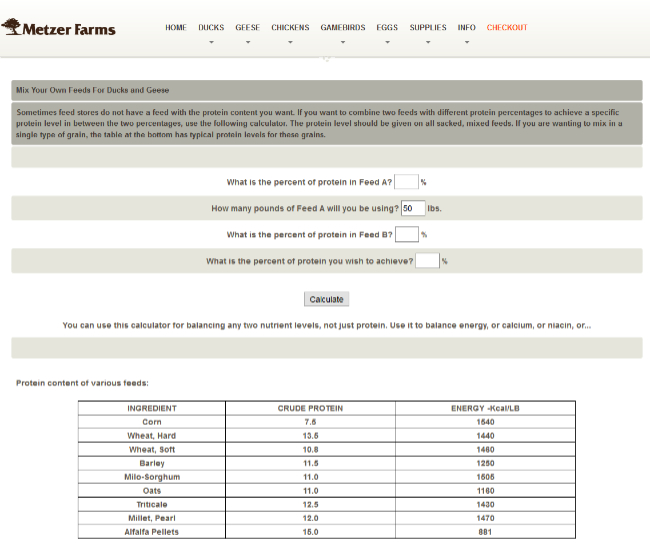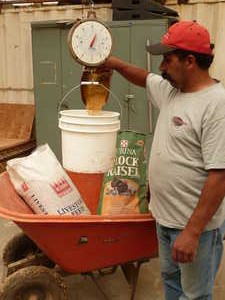Wednesday, August 18, 2010
Finding the appropriate feed is one of the biggest problems for a hobbyist or small flock owner. As we purchase 24 tons of feed every 8-10 days, our mill will make the feed any way we want it! But you probably don't have that luxury. You have to purchase it in bags and oftentimes there are few choices for you. I will show you how to mix what is available to achieve the ideal feed for you.
As ducks only need a starter feed for about three weeks when they are babies, and they don't consume a lot, it is better to purchase a higher quality feed than a lower quality feed if your local feed store does not have exactly what you want. We recommend a starter feed contain at least 21% protein. If your choices are a general poultry feed of 18% and a game bird starter feed of 28%, I would recommend you buy the game bird starter feed. It is more protein than they need but it will do no harm at that age.
Our recommendation is 17.5% protein from four to nine weeks of age. At this point the 18% protein feed is fine. But what do you do after that when we recommend 14.5% and you can only buy the 18% feed or scratch feed at 10%? Neither meets your needs.
As ducks only need a starter feed for about three weeks when they are babies, and they don't consume a lot, it is better to purchase a higher quality feed than a lower quality feed if your local feed store does not have exactly what you want. We recommend a starter feed contain at least 21% protein. If your choices are a general poultry feed of 18% and a game bird starter feed of 28%, I would recommend you buy the game bird starter feed. It is more protein than they need but it will do no harm at that age.
Our recommendation is 17.5% protein from four to nine weeks of age. At this point the 18% protein feed is fine. But what do you do after that when we recommend 14.5% and you can only buy the 18% feed or scratch feed at 10%? Neither meets your needs.

At this point I would go to our website and choose Care and Management on the home page menu. Then choose Mix Your Own Feeds. This program will tell you how much of two feeds to mix to achieve the protein level you want.
Let us assume you can only buy a general purpose poultry feed (Feed A) containing 18% protein and scratch grain (Feed B) that is only 10% protein. Let us also assume Feed A comes in 60 pound bags and you want to produce a feed with 14.5% protein.
Put "18" in the first field.
Put "60" in the second field.
Put "10" in the third field.
Put "14.5" in the fourth field, click on "Calculate", wait for a new page to pop up and then scroll down the page for the answer.
You will see that by mixing 47 pounds of scratch with 60 pounds of the general purpose poultry feed you will have a feed that averages 14.5% protein.
Let us assume you can only buy a general purpose poultry feed (Feed A) containing 18% protein and scratch grain (Feed B) that is only 10% protein. Let us also assume Feed A comes in 60 pound bags and you want to produce a feed with 14.5% protein.
Put "18" in the first field.
Put "60" in the second field.
Put "10" in the third field.
Put "14.5" in the fourth field, click on "Calculate", wait for a new page to pop up and then scroll down the page for the answer.
You will see that by mixing 47 pounds of scratch with 60 pounds of the general purpose poultry feed you will have a feed that averages 14.5% protein.

You will also see the page shows you the protein level of some common grains. You can use these numbers if you have a local source of these grains - maybe damaged grain from a local mill or you produce these grains yourself.
If you are only balancing for protein, there is no guarantee the final mixed level of calcium or niacin or energy or other nutrient levels is correct. But as protein level is the best indicator of overall feed quality, you can generally assume that the higher the protein level, the higher the level of other vital nutrients are in the feed.
Next week our blog will be on the goose breeding stock we purchased from Dave and Millie Holderread and how we plan to use them. See you then!
Enjoy your ducks and geese!
If you are only balancing for protein, there is no guarantee the final mixed level of calcium or niacin or energy or other nutrient levels is correct. But as protein level is the best indicator of overall feed quality, you can generally assume that the higher the protein level, the higher the level of other vital nutrients are in the feed.
Next week our blog will be on the goose breeding stock we purchased from Dave and Millie Holderread and how we plan to use them. See you then!
Enjoy your ducks and geese!